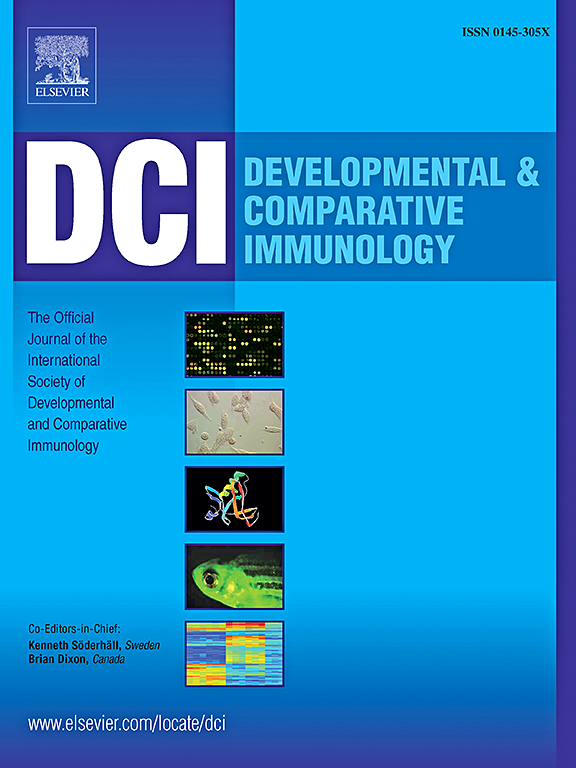Interferon regulatory factor 2 of red-spotted grouper (Epinephelus akaara): Insights into its transcriptional profiling, antiviral potential, and function in macrophage polarization
IF 2.7
3区 农林科学
Q1 FISHERIES
引用次数: 0
Abstract
Interferon regulatory factor 2 (IRF2) is a member of the IRF family that is specifically involved in diverse immune responses via interferon (IFN)/IRF-dependent signaling pathways. In this study, IRF2 of Epinephelus akaara (EAIRF2) was identified and characterized by evaluating its structural and functional properties. EAIRF2 showed the highest homology with IRF2 of Epinephelus coioides and clustered with teleosts in the phylogenetic tree. The highest level of EAIRF2 mRNA was found in the blood under normal physiological conditions. In the immune challenge experiment, significant transcriptional modulation of EAIRF2 upon lipopolysaccharide (LPS), polyinosinic: polycytidylic acid (poly I:C), and nervous necrosis virus (NNV) challenge were observed. The subcellular localization assay confirmed the role of EAIRF2 as a transcription factor by revealing its specific nuclear localization. To elucidate its functional implications in antiviral defense, EAIRF2 was overexpressed in fathead minnow cells, which were subsequently infected with viral hemorrhagic septicemia virus (VHSV). Notably, cells overexpressing EAIRF2 exhibited a significant reduction in the transcription of VHSV genes. Concurrently, the genes associated with the IFN/IRF signaling pathway were upregulated. Furthermore, the Hoechst and propidium iodide dual staining assay, water-soluble tetrazolium-1 (WST-1) assay, and transcriptional analysis of B-cell lymphoma 2-associated X protein (Bax)/B-cell lymphoma 2 (Bcl-2) indicated that EAIRF2 possesses anti-apoptotic properties during viral infection and poly I:C treatment. Additionally, EAIRF2 overexpression in murine macrophages induced M1 polarization and augmented relative marker gene expression. Collectively, these findings suggest that EAIRF2 is a pivotal immune-related gene, specifically implicated in the IFN/IRF-mediated antiviral defense mechanism, apoptotic signaling pathway, and activation of macrophage-mediated immune responses in Epinephelus akaara. The finding of this study enhances our understanding of IRF2's function in teleost immunity and presents potential avenues for developing therapeutic strategies against viral infections and other immune-related conditions in aquaculture species.
红斑石斑鱼(Epinephelus akaara)的干扰素调节因子2:对其转录谱、抗病毒潜力和巨噬细胞极化功能的见解
干扰素调节因子2 (IRF2)是IRF家族的一员,通过干扰素(IFN)/IRF依赖性信号通路特异性参与多种免疫反应。本研究通过评价Epinephelus akaara的IRF2 (EAIRF2)的结构和功能特性,对其进行了鉴定和表征。EAIRF2与石斑鱼的IRF2同源性最高,在系统发育树上与硬骨鱼聚集在一起。正常生理条件下,血液中EAIRF2 mRNA水平最高。在免疫攻击实验中,观察到EAIRF2在脂多糖(LPS)、多肌苷:多胞酸(poly I:C)和神经坏死病毒(NNV)攻击下的显著转录调节。亚细胞定位实验通过揭示EAIRF2特异性核定位证实了其作为转录因子的作用。为了阐明其在抗病毒防御中的功能意义,EAIRF2在随后感染病毒性出血性败血症病毒(VHSV)的小鱼细胞中过表达。值得注意的是,过表达EAIRF2的细胞表现出VHSV基因转录的显著减少。同时,与IFN/IRF信号通路相关的基因上调。此外,Hoechst和碘化丙烯双染色试验、水溶性四氮唑-1 (WST-1)试验和b细胞淋巴瘤2相关X蛋白(Bax)/ b细胞淋巴瘤2 (Bcl-2)转录分析表明,EAIRF2在病毒感染和poly I:C处理过程中具有抗凋亡特性。此外,小鼠巨噬细胞中EAIRF2的过表达诱导了M1极化并增强了相对标记基因的表达。综上所述,这些发现表明EAIRF2是一个关键的免疫相关基因,具体涉及石斑鱼IFN/ irf介导的抗病毒防御机制、凋亡信号通路和巨噬细胞介导的免疫反应的激活。本研究的发现增强了我们对IRF2在硬骨鱼免疫中的功能的理解,并为开发针对水产养殖物种病毒感染和其他免疫相关疾病的治疗策略提供了潜在的途径。
本文章由计算机程序翻译,如有差异,请以英文原文为准。
求助全文
约1分钟内获得全文
求助全文
来源期刊
CiteScore
6.20
自引率
6.90%
发文量
206
审稿时长
49 days
期刊介绍:
Developmental and Comparative Immunology (DCI) is an international journal that publishes articles describing original research in all areas of immunology, including comparative aspects of immunity and the evolution and development of the immune system. Manuscripts describing studies of immune systems in both vertebrates and invertebrates are welcome. All levels of immunological investigations are appropriate: organismal, cellular, biochemical and molecular genetics, extending to such fields as aging of the immune system, interaction between the immune and neuroendocrine system and intestinal immunity.

 求助内容:
求助内容: 应助结果提醒方式:
应助结果提醒方式:


